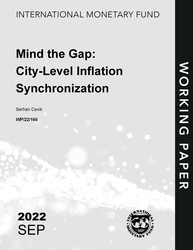
Mind the Gap: City-Level Inflation Synchronization
Mind the Gap: City-Level Inflation Synchronization
READ MORE...
Volume/Issue:
Volume 2022
Issue 166
Publication date: September 2022
ISBN: 9798400218613
$20.00
Add to Cart by clicking price of the language and format you'd like to purchase
Available Languages and Formats
| English |
Prices in red indicate formats that are not yet available but are forthcoming.
Topics covered in this book
This title contains information about the following subjects.
Click on a subject if you would like to see other titles with the same subjects.
Inflation , Economics- Macroeconomics , Economics / General , Inflation synchronization , subnational , transition economies , Lithuania , inflation subcomponent , inflation synchronicity , headline inflation inflation rate , correlation analysis , inflation dynamics , Inflation , Consumer price indexes , Consumer prices , Global financial crisis of 2008-2009 , Housing , Global
Also of interest
Summary
The post-pandemic rise in consumer prices across the world has renewed interest in inflation dynamics after decades of global disinflation. This paper provides a spatial investigation of inflation synchronicity at the city level in Lithuania using disaggregated monthly data during the period 2000–2021. The empirical analysis provides strong evidence that (i) the co-movement of city-level inflation rates—estimated using the instantaneous quasi-correlation approach—is significantly weaker than the extent of synchronization suggested by the simple correlation analysis; (ii) there is substantial heterogeneity in the instantaneous quasi-correlation of inflation subcomponents between city pairs; and (iii) there are significant changes in the degree of city-level synchronization over time, reflecting important economic developments in history such as the global financial crisis, the adoption of euro, and the COVID-19 pandemic.
Copyright © 2010 - 2026
Powered by:
AIDC



